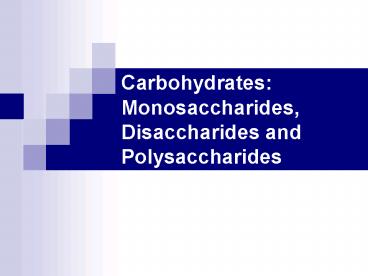Carbohydrates: Monosaccharides, Disaccharides and Polysaccharides - PowerPoint PPT Presentation
1 / 20
Title:
Carbohydrates: Monosaccharides, Disaccharides and Polysaccharides
Description:
Carbohydrates: Monosaccharides, Disaccharides and Polysaccharides Carbohydrates Contain carbon, hydrogen and oxygen Ratio hydrogen : oxygen 2:1 Monosaccharides (CH2O ... – PowerPoint PPT presentation
Number of Views:1632
Avg rating:3.0/5.0
Title: Carbohydrates: Monosaccharides, Disaccharides and Polysaccharides
1
Carbohydrates Monosaccharides, Disaccharides
and Polysaccharides
2
Carbohydrates
- Contain carbon, hydrogen and oxygen
- Ratio hydrogen oxygen 21
- Monosaccharides (CH2O)n n 3 to 9
- Disaccharides 2(CH2O)n H2O
- Polysaccharides (C6H10O5)n n gt 300
3
Monosaccharides
- Formula (CH2O)n
- C H O 121 ratio
- Contain carbonyl group CO
- Contain at least 2 hydroxyl groups OH
- Carbonyl and hydroxyl groups are the reactive
groups in the molecule
4
Trioses
H
O
H
Alkanal
C
C
OH
H
Alkanone
OH
H
H
C
C
O
H
H
H
OH
C
C
OH
H
Glyceraldehyde (aldose sugar)
Dihydroxyacetone (ketose sugar)
5
Pentoses
H
O
CH2OH
OH
C
O
C
OH
H
H
H
H
H
OH
H
C
OH
H
C
OH
OH
OH
H
C
H
Ribose - ring form
Ribose - chain form
6
Hexoses
1
6
CH2OH
H C O H C OH HO C H H C
OH H C OH H C OH
O
5
2
H
H
H
1
4
3
OH
H
OH
HO
4
2
3
H
OH
5
Glucose ring form
6
Glucose chain form
Aldose sugar
H
7
1
6
CH2OH
H C O H C OH HO C H HO C
H H C OH H C OH
O
5
2
H
HO
H
1
4
3
OH
H
OH
H
4
2
3
H
OH
5
Galactose Aldose sugar
6
H
8
H
1
H C OH C O HO C H H C
OH H C OH H C OH
CH2OH
O
CH2OH
2
3
OH
H
H
HO
4
5
OH
H
6
Fructose ketose sugar
H
9
CH2OH
CH2OH
O
O
OH
H
H
H
H
H
OH
OH
H
H
OH
H
HO
HO
H
OH
H
OH
a-glucose
ß-glucose
Hydroxyl group on C1 below the ring
Hydroxyl group on C1 above the ring
10
Disaccharides
- Formed by condensation reaction of two
monosaccharides - Water is removed
- Glycosidic bond is formed
11
maltose
glucose
glucose
CH2OH
CH2OH
CH2OH
CH2OH
O
O
H
H
H
H
O
O
H
H
H
H
H
H
H
H
H2O
OH
H
H
OH
H
OH
H
OH
O
OH
HO
HO
OH
HO
OH
OH
H
OH
H
H
H
OH
OH
a1,4-glycosidic bond
12
Disaccharide Constituent monosaccharide Type of glycosidic bond Occurrence
Lactose ß-galactose a-glucose ß1,4 glycosidic Found in mammalian milk
Maltose a-glucose a 1,4 glycosidic Formed by action of amylase on starch
Sucrose a-glucose ß-fructose a 1,2 glycosidic Found in sugar cane and sugar beet
13
Reducing and Non-Reducing Sugars
- Sugars that are oxidised on heating are known as
reducing sugars - Turn Benedicts reagent from blue (copper sulphate
to red (copper oxide) - All Monosaccharides are reducing sugars
- Disaccharides Lactose and Maltose are reducing
sugars - Sucrose is non-reducing
14
Polysaccharides
- Chains of monosaccharides
- Formed from condensation polymerisation
- Examples include
- Starch
- Cellulose
- Glycogen
All polymers of glucose
15
Polysaccharide Constituent Monosaccharide Type of Glycosidic Bond Shape of Molecule
Starch a-glucose (amylose) a1,4 glycosidic Unbranched chain wound into helix
Starch a-glucose (amylopectin) a 1,4 with some a 1,6 Tightly packed branched chain
Glycogen a-glucose a 1,4 with more a 1,6 than amylopectin Very branched compact molecule
Cellulose ß-glucose ß1,4 glycosidic Unbranched straight chains
16
Starch
- Polymer of a-glucose
- Mixture of amylose and amylopectin.
- 30 Amylose
- unbranched chains, a 1,4 glycosidic linkages.
- helical shape with 6 glucose residues per turn.
- 70 Amylopectin
- a 1,4 glycosidic linkages
- branches of a 1,6 glycosidic linkages
- usually every 20 to 30 residues.
17
Amylopectin
a 1,6 glycosidic linkage
O
O
O
O
a 1,4 glycosidic linkage
18
Glycogen
- Polymer of a-glucose monomers
- a 1,4 glycosidic linkages
- Branches a 1,6 glycosidic linkages every 8 to 12
residues along the chain. - Results in a very compact structure.
- Glycogen acts as an energy store in the liver and
muscles of animals.
19
Cellulose
- Cellulose is a polymer of ß-glucose
- ß 1,4 glycosidic linkages form straight
unbranched chains. - The chains do not coil into helices.
- Cellulose is an important structural component of
plant cell walls. - Only a few organisms possess the enzyme cellulase
that can hydrolyse cellulose to glucose.
20
Cellulose
O
O
O
O
O
O
O
O
O
O
O
O
ß 1,4 glycosidic linkage































